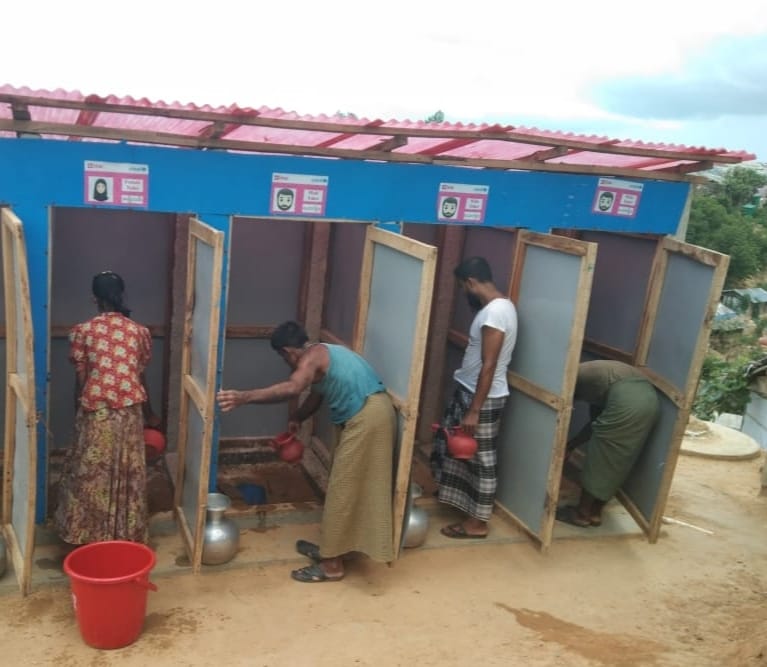BRAC, with the support of UNICEF, implemented the RANAS approach (Risk, Attitudes, Norms, Ability and Self-regulation, [F.20]) to develop an evidence-based intervention to improve the cleaning of shared latrines and, as a result, increase the use of latrines by the Rohingya communities in Cox’s Bazar, Bangladesh. This case study describes the process of latrine cleaning as one example of a total of nine behaviours targeted using the RANAS approach.

Pre-Conditions and Enabling Factors
At the time of the project, the Rohingya communities in Cox’s Bazar lived in densely populated conditions, sharing not only water points and bathing areas, but also their latrines with other families. Every latrine block was managed by a user group responsible for the cleanliness and maintenance of the latrines, with support from a dedicated NGO. In camp 14, BRAC was operating as a partner of UNICEF. The user groups did not function well and were often concerned with other tasks - leading to poor cleanliness and unused latrines.
Social and Behaviour Change
To trigger social and behaviour change, the RANAS approach (link) was employed. RANAS draws on the concept of ‘doers’ and ‘non-doers’ and aims to identify the different motivations of the two groups. The doers were those who habitually cleaned their shared latrines. Non-doers were those who did not, despite living in the same environment. The project was implemented in four steps. The first two steps used detailed qualitative and quantitative assessments to pinpoint the different behavioural and motivating factors; those psychological insights were then used in step three to inform a communication strategy drawing on the RANAS catalogue of behaviour change techniques to identify the most appropriate techniques. The final step was evaluation.
Assessment
BRAC conducted two assessment questionnaires based on the RANAS approach. The first entailed 20 qualitative interviews with community members. Interviews investigated the context of latrine cleaning, the community’s needs and related feelings, possible barriers and solutions as well as the prevailing social norms. The information was used to refine a second quantitative assessment questionnaire which BRAC conducted with 200 participants. These structured interviews asked participants about their Risk, Attitude, Norm, Ability and Self-regulation beliefs related to the cleaning of shared latrines. The results revealed that doers (people who habitually cleaned their shared latrines) were more likely to view the cleaning as the social norm, believing that others were also cleaning the latrines and that their community leaders approved of this. They felt proud to be cleaning the latrines and less ashamed and disgusted than non-doers. They had a better ability to overcome any barriers to cleaning and plan the actions for how they would do it. Doers had more confidence in their performance, believing that they would always be able to clean the latrines.
Communication
The assessment findings informed the subsequent evidence-based behaviour change campaign. The campaign employed several communication channels: user group meetings, household visits and talks with the Imam/Majhi. During the user group meetings, participants were invited to share their feelings - positive and negative - related to latrine cleaning, practise cleaning the facilities together and develop detailed cleaning schedules to ensure the involvement of each family. The group also discussed how to provide support if families were unable to fulfil their responsibilities. They discussed the possible problems that might arise with latrine cleaning and how they could overcome them (individual barrier planning). They also made a public promise to clean the latrines (public commitment to target social norms). The household visits and meetings with the Imam/Majhi partly repeated and strengthened the messages delivered in the user group meetings.
Community Engagement and Participation
The active participation and problem solving of community members were encouraged. BRAC interviewed men, women and households with members with disabilities. Religious and community leaders were involved in the campaign. A feedback mechanism was set up for participants to report any complaints related to the process.
MEAL
The same participants interviewed during the second assessment were interviewed for an evaluation following implementation. Any positive changes in their mindset and behaviour would indicate success of the activities. The evaluation included questions about the acceptability of the intervention and suggestions for improvements. Compared to the baseline an additional 66% of participants had a detailed plan of when to clean the latrines and 47% more families reported following those plans, resulting in a 48% increase in clean latrines. These changes in behaviour were achieved through influencing social norms, action and barrier planning and the reduction of negative feelings like shame and disgust.





